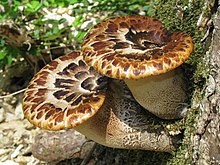Loading AI tools
Species of fungus From Wikipedia, the free encyclopedia
Cerioporus squamosus synonym Polyporus squamosus is a basidiomycete bracket fungus, with common names including dryad's saddle and pheasant's back mushroom.[2] It has a widespread distribution, being found in North America, Australia, and Eurasia, where it causes a white rot in the heartwood of living and dead hardwood trees. The name "dryad's saddle" refers to creatures in Greek mythology called dryads who could conceivably sit and rest on this mushroom, whereas the pheasant's back analogy derives from the pattern of colors on the bracket matching that of a pheasant's back.
| Cerioporus squamosus | |
|---|---|
 | |
| Scientific classification | |
| Domain: | Eukaryota |
| Kingdom: | Fungi |
| Division: | Basidiomycota |
| Class: | Agaricomycetes |
| Order: | Polyporales |
| Family: | Polyporaceae |
| Genus: | Cerioporus |
| Species: | C. squamosus |
| Binomial name | |
| Cerioporus squamosus | |
| Synonyms | |
|
Polyporus squamosus Species synonymy[1]
| |
| Cerioporus squamosus | |
|---|---|
| Pores on hymenium | |
| Cap is depressed or offset | |
| Hymenium is decurrent | |
| Stipe is bare | |
| Spore print is white | |
| Ecology is saprotrophic or parasitic | |
| Edibility is edible or inedible | |

Squamosus comes from the Latin squamosus meaning covered with scales or scaly,[3] referring to the signature dark brown scales found on the mushroom's cap.
The species was first described scientifically by British botanist William Hudson in 1778, who named it Boletus squamosus.[4] It was given its current name in 1886 by Quélet but is still widely known by the Friesian name "Polyporus squamosus".[5]
Dryad's saddle is an annual[6] mushroom commonly found attached to dead logs and stumps or on living hardwood trees at one point with a thick stem. Generally, the fruit body is round and between 8–30 centimetres (3–12 inches) across and up to 10 cm (4 in) thick. The body can be yellow to brown and has "squamules" or scales on its upper side. On the underside one can see the pores that are characteristic of the genus Cerioporus; they are made up of tubes packed together closely. The tubes are between 1 and 12 mm (1⁄32 and 15⁄32 in) long. The stalk is thick and short, up to 5 cm (2 in) long.[2] The fruit body will produce a white spore print if laid onto a sheet of paper. The spores are 11-15 x 4-5 μm and are long and smooth ellipsoids. They can be found alone, in clusters of two or three, or forming shelves. Young specimens are soft but toughen with age. It is particularly common on dead elm and is also found on living maple trees.
This organism is common and widespread, being found east of the Rocky Mountains in the United States and over much of Europe. It is also found in Australia and Asia. It commonly fruits in the spring, occasionally during autumn, and rarely during other seasons. Many mushroom hunters will stumble upon this when looking for morels during the spring as both have similar fruiting times, and this fungus can grow to a noticeable size of up to 50 cm (20 in) across.[7] It plays an important role in woodland ecosystems by decomposing wood, usually elm, silver maple, or box elder[6] but is occasionally a parasite on living trees. Other tree hosts include ash, beech, horse chestnut, Persian walnut, lime, maple, planetree, poplar, magnolia, and willow.[8]
Edible when young.[9] They can become infested with maggots and become firm, rubbery and inedible as they mature. Cookbooks dealing with preparation generally recommend gathering these while young, slicing them into small pieces and cooking them over a low heat. Some people value the thick, stiff paper that can be made from this and many other mushrooms of the genus Cerioporus. The mushroom's smell resembles watermelon rind.[2] Cerioporus squamosus has a mild nutty flavour.
Seamless Wikipedia browsing. On steroids.
Every time you click a link to Wikipedia, Wiktionary or Wikiquote in your browser's search results, it will show the modern Wikiwand interface.
Wikiwand extension is a five stars, simple, with minimum permission required to keep your browsing private, safe and transparent.